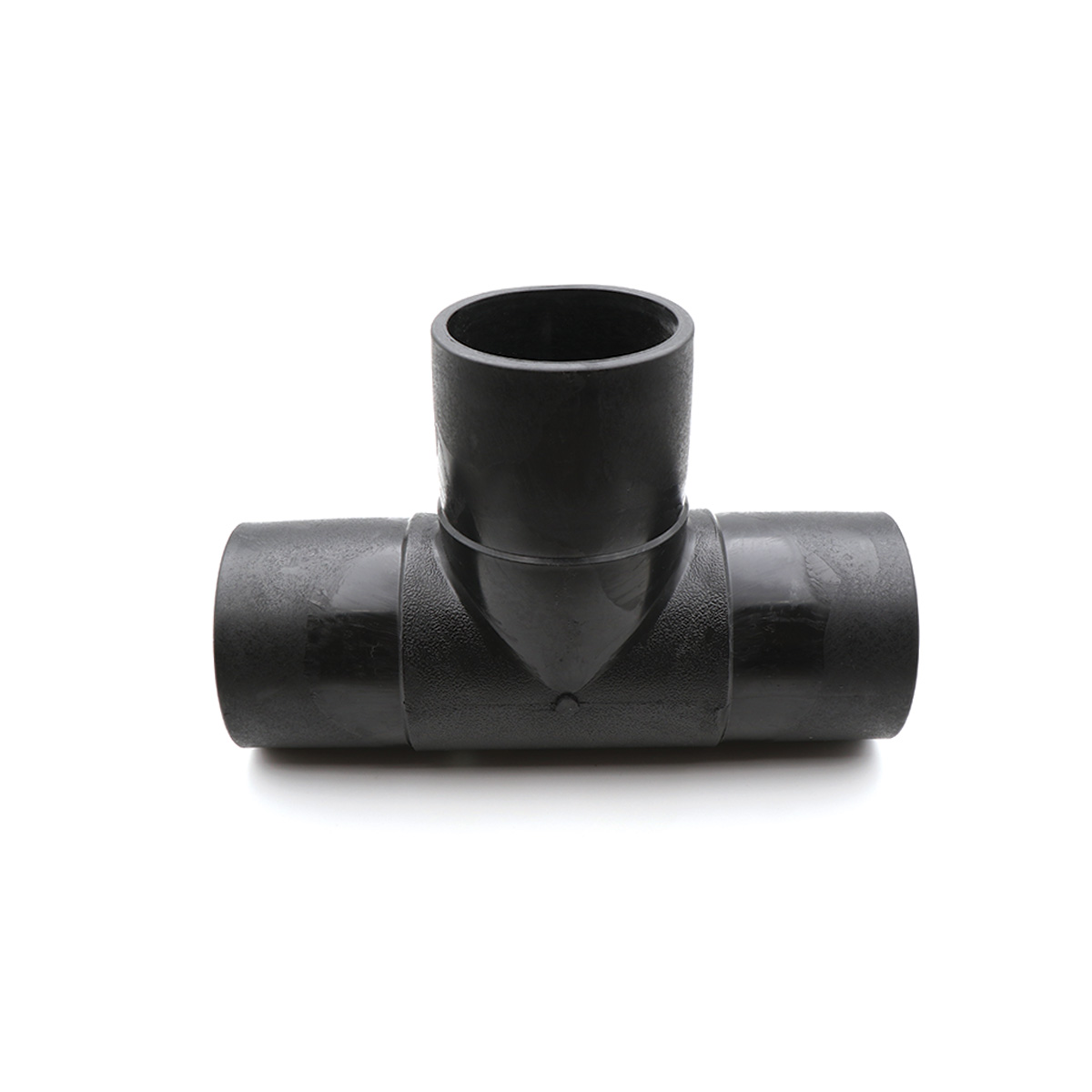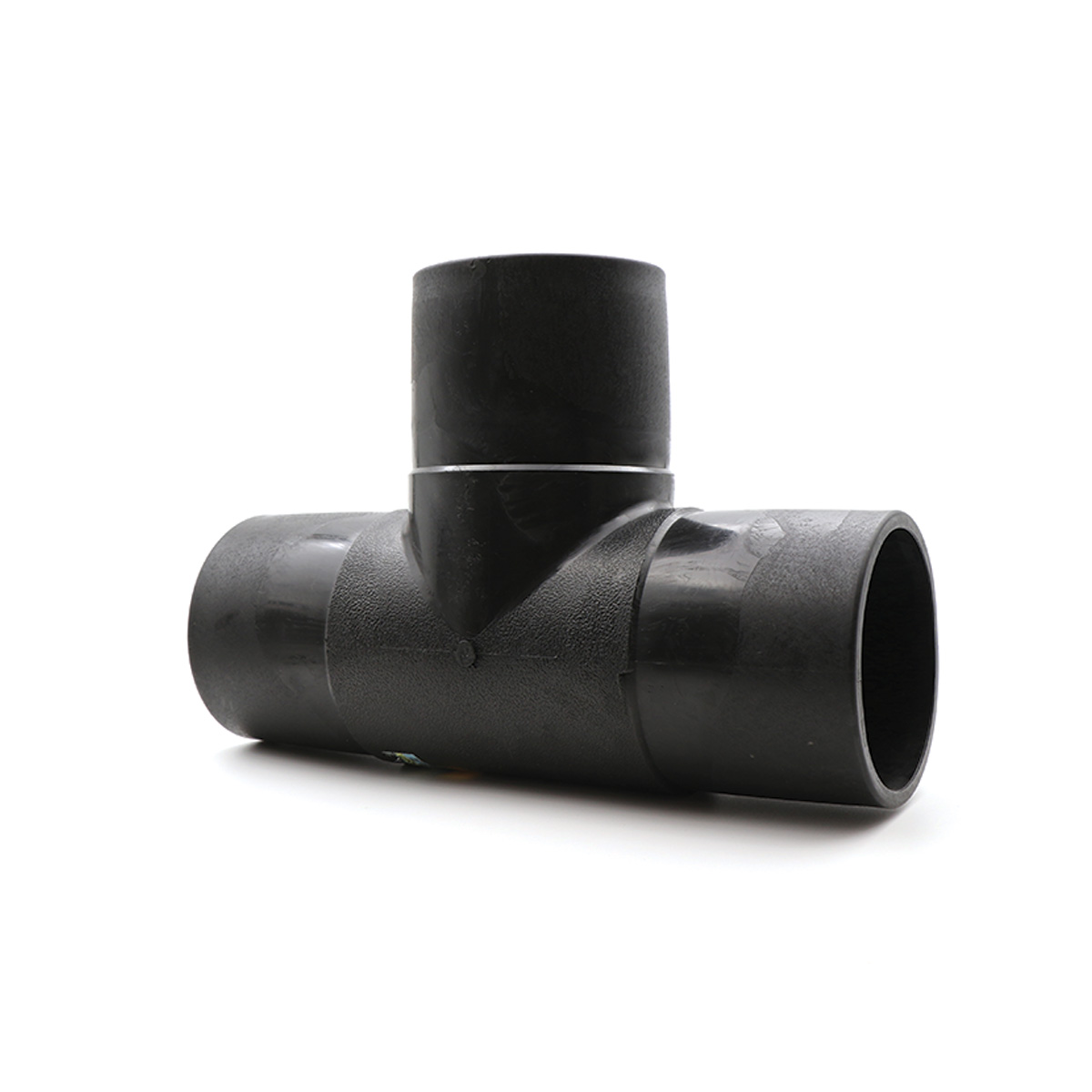A high-pressure polyethylene tee is used when a pipeline needs to be split into two safe, standard branches or when the flow direction must change. This fitting is used in municipal and rural water and wastewater networks, gas distribution, oil and petrochemical industries, pressurized irrigation systems, and process lines; with proper selection of size, pressure class, branch angle, and joining method, it ensures long-term network stability.
What is a polyethylene tee and what does it do?
A tee (Tee) is a molded or machined polyethylene fitting (mainly PE100 and, in some projects, PE100-RC) that creates equal or reducing branches at 90°, 60°, or 45°. Polyethylene, thanks to its low weight, flexibility, high chemical resistance, and impact tolerance, is a reliable option for networks subject to thermal and mechanical stresses.
Key advantages
- Excellent resistance to corrosion and scaling compared with metals
- Homogeneous joint via butt-fusion or electrofusion and stable sealing
- Working temperature range typical of water projects (usually around −20 to +40 °C depending on grade and project standard)
- Low pressure drop due to smooth internal surface
- Ability to absorb minor bedding and seismic deflections versus rigid fittings
Types of polyethylene tees
- Equal 90° tee (injection-molded or welded): all three outlets the same size; suitable for standard branching from the main.
- Reducing tee (unequal): branch smaller or larger than the main; optimal for local flow reduction.
- 60° and 45° tees (machined): for smoother direction change and reduced turbulence.
- Electrofusion tee: with internal coil for clean, controlled welding; suitable for confined spaces or repairs.
- Flanged tee (steel-core): for demountable connections in industrial units.
Technical selection criteria
- Nominal size (DN): in line with the outside diameter of PE pipes.
- Pressure class/SDR: ratio of diameter to wall thickness (SDR = do/sd_o / s) aligned with the system working pressure.
- Branch angle and type: 90°, 60°, or 45°; equal or reducing.
- Joining method: butt-fusion for medium and large sizes; electrofusion for critical and repair points; mechanical/flanged for equipment.
- Installation conditions: ambient temperature, access space, moisture/contamination control, operator skill.
Butt-fusion joining method for polyethylene tees
- Calibration & safety: ensure the butt-fusion machine is set and calibrated; use a tent/shield in wind, rain, or low temperatures.
- Preparation: cap both pipe ends with suitable end caps to reduce air flow. Clean pipe and tee edges; control alignment with clamps and rollers.
- Uniform heating: place the hot plate with uniform temperature between the two faces; press the parts initially to form an even bead.
- Remove plate & final pressing: after heat penetration, reduce pressure, remove the plate quickly and cleanly, then apply welding pressure.
- Stress-free cooling: hold the assembly steady until fully cooled; avoid thermal shock.
Important execution notes
- Tee and pipe wall thickness identical or as per manufacturer’s instruction.
- Ambient temperature at the welding location above 5 °C; workplace dry and protected.
- Contact surfaces free of dust, moisture, and scratches.
- Precise coaxiality; any misalignment can create residual stress.
Dimensional definition of Z, Z1, and L in a 90° equal tee
- Z: overall length of the tee.
- Z1: distance from the centerline of the two parallel ends to the end of the third outlet.
- L: height of each side from center to joint edge.
These three dimensional indices are vital for design, layout, and installation space calculations.
Nominal size table for 90° equal polyethylene tee (injection-molded)
The values below are for common project samples. When ordering, match each item’s details with the part datasheet.
| Item description | Z (mm) | Z1 (mm) | L (mm) |
|---|---|---|---|
| Injection-molded 90° PE tee 500 | 970 | 511 | 201 |
| Injection-molded 90° PE tee 450 | 970 | 511 | 201 |
| Injection-molded 90° PE tee 400 | 645 | 325 | 125 |
| Injection-molded 90° PE tee 355 | 651 | 326 | 125 |
| Injection-molded 90° PE tee 315 | 596 | 299 | 125 |
| Injection-molded 90° PE tee 280 | 601 | 324 | 101 |
| Injection-molded 90° PE tee 250 | 517 | 282 | 101 |
| Injection-molded 90° PE tee 225 | 454 | 262 | 102 |
| Injection-molded 90° PE tee 200 | 450 | 239 | 108 |
| Injection-molded 90° PE tee 180 | 466 | 234 | 107 |
| Injection-molded 90° PE tee 160 | 400 | 200 | 102 |
| Injection-molded 90° PE tee 140 | 375 | 194 | 35 |
| Injection-molded 90° PE tee 125 | 290 | 147 | 67 |
| Injection-molded 90° PE tee 110 | 317 | 159 | 85 |
| Injection-molded 90° PE tee 90 | 247 | 136 | 70 |
| Injection-molded 90° PE tee 75 | 248 | 124 | 72 |
| Injection-molded 90° PE tee 63 | 221 | 106 | 60 |
| Injection-molded 90° PE tee 50 | 208 | 108 | 59 |
| Injection-molded 90° PE tee 40 | 151 | 96 | 38 |
| Injection-molded 90° PE tee 32 | 133 | 81 | 28 |
Quick selection table by application
| Application | Typical operating pressure | Recommended SDR* | Common joining method | Recommended tee type |
|---|---|---|---|---|
| Urban water supply | 10–16 bar | SDR11/13.6 | Butt-fusion, electrofusion | Equal 90° or 45° |
| Pressurized irrigation | 6–10 bar | SDR17/13.6 | Butt-fusion | Equal 90° |
| Gravity/pressure sewage | 3–10 bar | SDR26/17 | Butt-fusion, flanged | Equal or reducing 45° |
| Gas distribution | Per operator specifications | SDR11 (common) | Electrofusion | Equal/reducing 90° |
| Oil & petrochemical | Fluid/temperature dependent | SDR11/13.6 | Flanged, electrofusion | Flanged or reinforced |
* SDR and pressure class must align with the project standard, service temperature, and safety factor.
Other widely used polyethylene tees
- Custom 90° equal tee
- Reducing polyethylene tee
- 60° polyethylene tee (machined)
- 45° polyethylene tee (machined)
- Electrofusion tee
- Reducing electrofusion tee
- Branch valve tee
- 90° corrugated tee
- Equal flanged tee with steel core
- Unequal flanged tee with steel core
Quality control and inspection notes
- Traceability of raw-material batch number (PE100/PE100-RC) and pressure test certificate.
- Dimensional inspection of Z, Z1, and L and check for end ovality.
- Visual inspection of the weld bead and leak test after installation.
- Observe minimum heating/cooling times per the welding machine manufacturer’s instructions.
About polyethylene tees
Polyethylene tees, in size ranges of 63 to 250 mm (and in some project portfolios up to 500), and with various angles, are designed for water networks, irrigation, and process industries. Molding quality, precise coaxiality of outlets, and compatibility with butt-fusion and electrofusion enable reliable installation and stable sealing. For correct selection, study the schematic and dimensional table of each code and align with SDR and the project working pressure.
Support and consultation
For guidance in choosing equal vs. reducing tees, calculating SDR appropriate to pressure and temperature, and matching joining methods to site conditions, consult your technical supplier team to ensure full product–project compatibility.
TamamBaha supplies polyethylene tees for water, gas, irrigation, and industrial projects. While not the only vendor, TamamBaha supports public utilities and contractors with a diverse portfolio, practical technical advice, and logistics coordination—helping teams choose the right size, pressure class, and joining method (butt-fusion/electrofusion/flanged) to streamline installation time and total cost of ownership for English-speaking markets.



